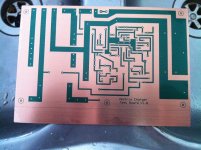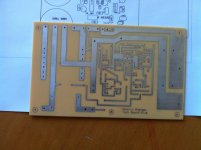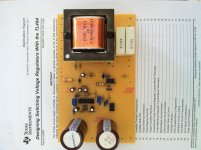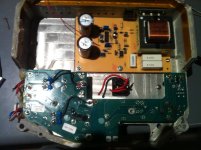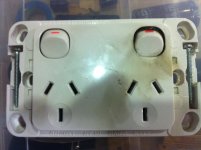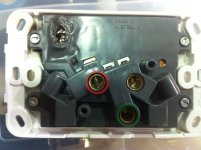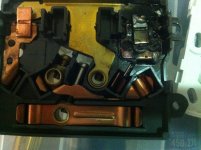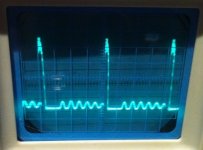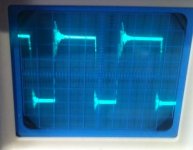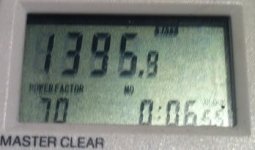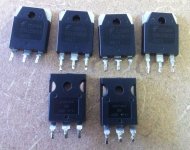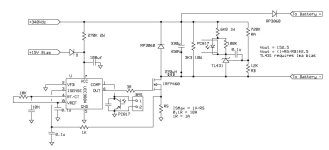heathyoung
100 kW
Important - this is an unisolated buck topology - the output floats at 1/2 rectified mains potential! Do not come into contact with the battery pack while it is being charged, or the output leads of the charger when it is on. You have been warned!
History:A year or so back I bought a brand new vectrix with a dead charger, no batteries and a dead motor controller.
I repaired the motor controller, and have fitted it with Lithium batteries, but the cheap and nasty BMS battery chargers I have been using to charge it with have a nasty habit of turning themselves inside out on a fairly regular basis - they are poorly designed, and no amount of fixing them will resolve their isues.
The original charger was a full-bridge, with PFC and all sorts of extra complexity, that defied my attempts to repair it (took full PFC output voltage (some 400V) across components designed for 5V) - so using that was out of the question. It did have some nice bits (including a very nice cast aluminium chassis) and custom wound inductors for the PFC and output filter, along with some nice low ESR electrolytics, and an input/output CMRR choke section designed to handle bulk current.
I came across the DIYElectricCar charger using large IGBT's and chokes in an unisolated buck configuration (not a big deal when EV packs are isolated from chassis) but the size was too large (needed 1.5-2Kw vs 10Kw) and the use of microcontrollers in a power supply - don't like it. They have their place, but this isn't it.
So I designed my own - I wrote a useful excel calculator for determining the correct frequency for the inductor I was using, and using the TL494 design guide written by TI (note - there are numerous errors in this!), along with the design guidelines for the IR2125 high-side driver.
Since this is designed to be completely open-source, I will publish the schematics and all of the information, I split the schematics for clarity.
Design:
My design goals were:
Constant Current (0-12A)
Constant Voltage (0-150V)
BMS Control with soft-start resume
Inrush current limiting with Bypass (important - thermal inertia of the NTC thermo and power wastage is a concern!)
Robust drive section that can handle abuse and cycle-by-cycle current limiting to protect devices.
DC input capable for dump charging from a Sealed Lead Acid bank
With the exception of the last item, a good charger (such as the Elcon) would fit the bill nicely, but a $600 pricetag, and the fact it doesn't fit anywhere nicely on the bike kills that idea!
Control section - this is based on a TL494, running as a single ended configuration at 100khz. The first opamp buffers the output from the voltage divider (no real reason apart from that there was a spare one, and it limits the output to the bias rail if something goes bad) the second amplifies the shunt output by 10X. The two pots control the V and A limits. The BMS input sits across the soft start section, which ramps the output over 10 cycles. When the BMS gets triggered, the TL494 stops pulse output to the IGBT driver, and soft-starts when it is removed.
View attachment Control_Section.pdf

Inrush current limiting - Very simple, basically a 3 second delay circuit when the power is applied - this drives a relay to close across an NTC thermister in series with the bridge rectifier that charges the resovoir caps - The low ESR 1500uF @ 360V bank draws a LOT of current, so a very robust NTC is required, anything smaller actually explodes on start-up (ask me how I know that). During startup, the only thing the NTC needs to be doing is charging the caps - not supporting the load of the charger, so there is an additional relay that sits across the soft start circuit so the charger only starts to produce output when the soft-starter is done.
View attachment Soft_Start.pdf
Drive section - this is based on an IR2125 set up for current limiting - there is a fast recovery diode across the resistor to speed up the discharge of the gate, bypassing the resistor and allowing the gate to discharge FAST. The effects on the gate drive are very noticible in the scope traces, reduces the amount of time the IGBT is not saturated. The 7555 timer provides extra boostrap voltage for very high and very low duty cycles. The shunt resistor on the drive section provides cycle-by-cycle current limiting to protect the IGBT if something goes bad. The IGBT and recovery diodes are heavily over-specced for robustness, 2Kw is very possible with these components. The choke is a custom job from the output filter of a Vectrix charger, but high power chokes are readily available.
View attachment 5


View attachment Driver_Section.pdf
History:A year or so back I bought a brand new vectrix with a dead charger, no batteries and a dead motor controller.
I repaired the motor controller, and have fitted it with Lithium batteries, but the cheap and nasty BMS battery chargers I have been using to charge it with have a nasty habit of turning themselves inside out on a fairly regular basis - they are poorly designed, and no amount of fixing them will resolve their isues.
The original charger was a full-bridge, with PFC and all sorts of extra complexity, that defied my attempts to repair it (took full PFC output voltage (some 400V) across components designed for 5V) - so using that was out of the question. It did have some nice bits (including a very nice cast aluminium chassis) and custom wound inductors for the PFC and output filter, along with some nice low ESR electrolytics, and an input/output CMRR choke section designed to handle bulk current.
I came across the DIYElectricCar charger using large IGBT's and chokes in an unisolated buck configuration (not a big deal when EV packs are isolated from chassis) but the size was too large (needed 1.5-2Kw vs 10Kw) and the use of microcontrollers in a power supply - don't like it. They have their place, but this isn't it.
So I designed my own - I wrote a useful excel calculator for determining the correct frequency for the inductor I was using, and using the TL494 design guide written by TI (note - there are numerous errors in this!), along with the design guidelines for the IR2125 high-side driver.
Since this is designed to be completely open-source, I will publish the schematics and all of the information, I split the schematics for clarity.
Design:
My design goals were:
Constant Current (0-12A)
Constant Voltage (0-150V)
BMS Control with soft-start resume
Inrush current limiting with Bypass (important - thermal inertia of the NTC thermo and power wastage is a concern!)
Robust drive section that can handle abuse and cycle-by-cycle current limiting to protect devices.
DC input capable for dump charging from a Sealed Lead Acid bank
With the exception of the last item, a good charger (such as the Elcon) would fit the bill nicely, but a $600 pricetag, and the fact it doesn't fit anywhere nicely on the bike kills that idea!
Control section - this is based on a TL494, running as a single ended configuration at 100khz. The first opamp buffers the output from the voltage divider (no real reason apart from that there was a spare one, and it limits the output to the bias rail if something goes bad) the second amplifies the shunt output by 10X. The two pots control the V and A limits. The BMS input sits across the soft start section, which ramps the output over 10 cycles. When the BMS gets triggered, the TL494 stops pulse output to the IGBT driver, and soft-starts when it is removed.
View attachment Control_Section.pdf

Inrush current limiting - Very simple, basically a 3 second delay circuit when the power is applied - this drives a relay to close across an NTC thermister in series with the bridge rectifier that charges the resovoir caps - The low ESR 1500uF @ 360V bank draws a LOT of current, so a very robust NTC is required, anything smaller actually explodes on start-up (ask me how I know that). During startup, the only thing the NTC needs to be doing is charging the caps - not supporting the load of the charger, so there is an additional relay that sits across the soft start circuit so the charger only starts to produce output when the soft-starter is done.
View attachment Soft_Start.pdf
Drive section - this is based on an IR2125 set up for current limiting - there is a fast recovery diode across the resistor to speed up the discharge of the gate, bypassing the resistor and allowing the gate to discharge FAST. The effects on the gate drive are very noticible in the scope traces, reduces the amount of time the IGBT is not saturated. The 7555 timer provides extra boostrap voltage for very high and very low duty cycles. The shunt resistor on the drive section provides cycle-by-cycle current limiting to protect the IGBT if something goes bad. The IGBT and recovery diodes are heavily over-specced for robustness, 2Kw is very possible with these components. The choke is a custom job from the output filter of a Vectrix charger, but high power chokes are readily available.
View attachment 5


View attachment Driver_Section.pdf


